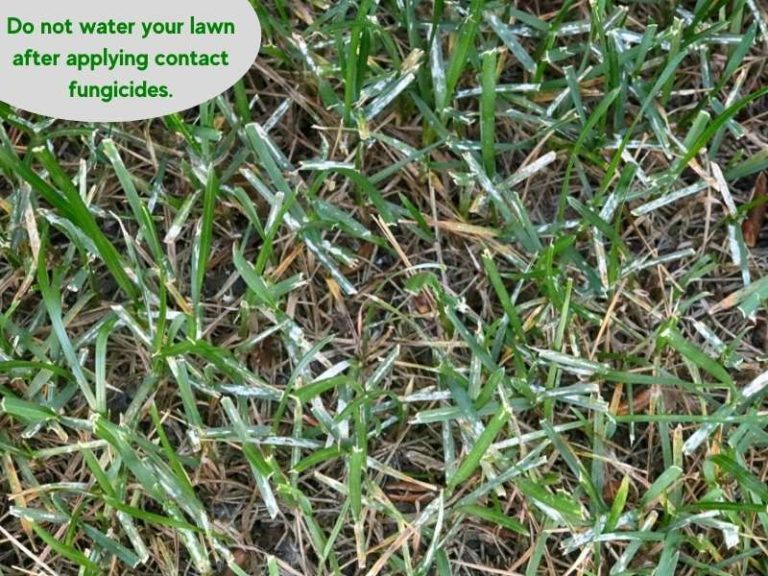Can You Overwater New Sod
Newgrass sod needs water for proper root establishment. As much as grass loves water, too much water harms new sod. New sod is still too delicate to retain water. Therefore, careful water management must ensure new sod is appropriately watered to full growth.
Technically, you CAN overwater new sod – and it’s pretty easy, too. Just because you can, doesn’t mean you should. Overwatering new sod will overwhelm the roots’ water retention. Overwatering will lead to oxygen deprivation, root rot, and eventual grass death. Proper irrigation and aeration routines are the answer to reviving and saving your lawn.
What is the proper approach to watering new sod? I’ll break down the dos and don’ts of watering new sod.
Signs of overwatering new sod
The signs of overwatering new sod include spongy sod, soggy soil, roots failing to knit, root rot, wilting, fungal diseases, and leaf blade discoloration.
Spongy sod/ muddy soil
If you have soggy lawn or the sod feels spongy and the soil underneath feels soggy, you’re likely over-hydrating your new sod. Under proper irrigation, the new turf should feel moist, not spongy. Meanwhile, the soil should also be damp, not muddy.
Failure to root
Once you’ve noticed that the new sod is too wet, you can check for other signs of waterlogging, such as whether rooting has occurred or not. Simply lift one corner of the sod. If it lifts easily and you can see rotting roots underneath, you have a waterlogging issue.
Carefully watered new sod shouldn’t be able to lift easily about two weeks after being installed, as the roots will have taken hold in the ground.
Root rot
Root rot is the most common symptom of excessive watering on newly-installed grass sod. Usually, root rot occurs in the summer when underground bacteria are more active and the roots are saturated in excess water.
You can tell the roots of your new sod are rotting if they feel mushy, are brown, and have a characteristic decaying smell.
Wilting/ discoloration
Wilting and discoloration on grass blades are strong signs of stress caused by overwatering of the sod. Waterlogged soils reduce the roots’ ability to take up oxygen and nutrients.
Without the proper nutrients, the leaf blades appear limp and start to lose their green. Eventually, they turn yellow, then brown, and die.
Fungal infestation
Overwatering new sod provides optimal conditions for fungal organisms that thrive in moist conditions. These fungi negatively affect the health of your turf and lead to diseases like brown patch disease and pythium blight.
Proper drainage, moderate watering, core aeration, and exposure to sunlight reduce the survival rate for most of these fungal organisms. In turn, the sod has a better chance of healthy growth.
Can you over-water new sod?
Here is a table summary of how deep you should water new sod depending on the grass variety.
| Turf Grass Variety | Watering Requirements |
| Bermuda grass sod | 0.5 inches of water per day. Bermuda water needs also differ per season. |
| St. Augustine grass | 1 inch of water per week |
| Centipede grass | 0.5-1.0 inches of water per week |
| Tall fescue | 1-1.5 inches of water per week |
| Kentucky bluegrass | 1 inch of water per week (in the growing season) 2-2.5 inches of water per week (in the heat of the summer) |
It’s possible to overwater new sod, especially if you’re not keeping tabs on the turf conditions or the soil moisture levels. Ideally, you should irrigate new grass sod at least once daily for the first 3-4 weeks post-installation. However, maintaining this irrigation schedule in rainy or cold weather could lead to an overwatered lawn.
To avoid overwatering new sod, insert a finger in the soil to determine the soil moisture depth. If the soil is still moist after one inch, you’re overwatering the new lawn. Alternatively, a soil moisture sensor indicates whether the soil is moist or dry at every depth.
You’re also more likely to overwater new sod if you plant it at the wrong time of the year. Remember, turf grasses use up groundwater faster when they’re actively growing. When you plant warm-season sod in the fall when it’s not actively growing, you’re more likely to feed it with more water than it needs. The same also goes for cool-season sod planted in the spring.
Note: Another factor that commonly causes overwatering of new sod is a lawn with compacted soil that doesn’t drain water fast enough.
Can overwatered sod recover?
You can still bring your overwatered sod back to life. As such, diagnosing the overwatering issue in its early stages greatly boosts your turfgrass’ recovery chances. Stop watering the turf for a while once you notice that your lawn is waterlogged.
Adopt the right watering schedule
Once the turf is considerably dry, adopt a new watering schedule that entails less watering. Cutting back on irrigation won’t make grass that has already wilted or discolored turn green again. But, it’ll help the turf develop new, healthy growth. Your watering practices should be determined by the maturity of your region’s turfgrass and rainfall conditions.
For instance, hydrate newly-laid sod at least once per day until the roots are well-established in the soil. Once the roots take hold, you should cut back on the watering frequency to about twice per week. Still, water deeply during each session.
Avoid irrigating the lawn during heavy rainfall until the top inch of the soil feels dry or until the grass shows signs of drought stress several days after the rains subside. On the contrary, water deeply and consistently during periods of prolonged drought.
Apart from adopting the right watering practices, you can revive overwatered sod by aerating the lawn, dethatching, laying fresh sod, and seeding heavily affected turf sections.
Aerate the lawn
Aerate your lawn to relieve soil compaction to allow the soil to drain through the soil faster and prevent waterlogged conditions. Lawn soil aeration is best done using a core aerator.
Note: Aerating a lawn creates more pockets in the soil, allowing water to drain through easily and more oxygen to reach the grass roots.
Dethatch the lawn
Dethatching allows more sunlight and atmospheric heat to reach and penetrate the soil, thereby facilitating evaporation and preventing waterlogged soil. Use a hand rake, a power dethatcher, or a verticutter to dethatch your lawn and relieve waterlogging caused by heavy thatch buildup.
Which is the best way to water new sod?
The best way to irrigate new sod depends on how old the turf is post-installation. Newly-laid sod should be watered starting from the first day you install it.
On the first day, soak the soil to a depth of 3-4 inches to prevent the new turf from drying out. Then, from day 2-5 post-installation, deeply water the newly-sodded turf twice a day, once in the morning and once in the afternoon.
Maintain this watering schedule from day 6-9 while also hand-watering any dry areas on the lawn. The seams between the sod pieces and the edges of the lawn are usually the most likely areas to dry out.
Also, consider the amount of rainfall received to avoid saturating the lawn. For instance, if you’ve received two inches of rainfall, don’t add more than two inches of water. Basically, the total soil moisture depth shouldn’t exceed 4 inches in well-drained soil.
From day 10 to 15, you can reduce the watering frequency to once per day. The grass roots will have grown deeper into the soil, and the turf will need less water. However, you should water deeply during each session. At this stage, look out for fungal diseases caused by overwatering.
Note: You can tell the roots are well-established in the soil if you lift the sod pieces and feel resistance.
From day 16 onwards, you should cut back on the amount of water applied even further. Water deeply but infrequently, with the total amount of water applied in a week not exceeding 1 inch.
Is watering new sod a good idea?
Watering new sod is a great idea. Keeping the turf dry leaves it vulnerable to drought stress. The leaf blades of under-watered turf grass usually turn gray before shrinking and wilting as the drought worsens. The result is an unsightly, slow-growing lawn more vulnerable to weed infestation.
While failing to water or underwatering causes problems for new sod, overwatering it isn’t helpful either. You need to keep the new sod moist without saturating it.
What’s the best time of day to water new sod?
The best time of day to water new sod is early morning. The weather is usually colder and less windy at this time. Therefore, water evaporates slower. This reduces moisture loss leading to underwatering/drought stress.
Avoid watering new sod in the afternoon or at night. It’s usually warmer in the afternoon, and water evaporates before it’s absorbed. Meanwhile, it’s windier at night, encouraging faster evaporation.
Watering tips for new sod to avoid overwatering
- Before watering your lawn, insert a sharp tool such as a screwdriver into the soil. The lawn is overwatered if it still feels easy to push into the soil after four inches. You should wait for it to dry before the next irrigation cycle.
- Avoid watering your lawn by hand, as it’s hard to achieve uniform coverage using this irrigation method. You’ll likely end up with overwatered and under-watered spots on the lawn. Instead, use horse-end sprinklers and in-ground watering systems.
References
- Glenn Hardebeck and Zac Reicher, Purdue University Turfgrass science program: Establishing a Lawn from Sod
- Kansas State University, Turf Grass and Landscape Research and Extension: Fungi thriving in wet Conditions



![How to Fix a Muddy Yard [Solutions to Dry Up a Wet Yard Fast]](https://lawnmodel.com/wp-content/uploads/2021/01/How-to-Fix-a-Muddy-Yard-Dry-up-the-yard.jpg)
